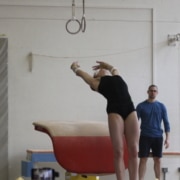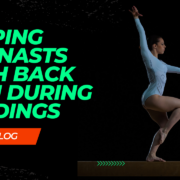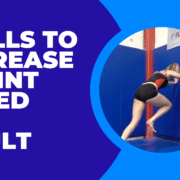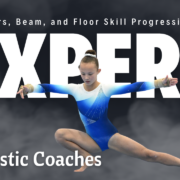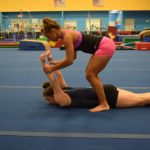How To Quickly Screen A Gymnast’s Ankle Mobility
The concept of screening is something huge I think the gymnastics world need to regularly partake in due to the high physical demands and injury rates. Screening refers to the idea of performing tests or movement assessments on gymnasts regularly to detect possible risk factors for problems. I have mentioned a few screening tests in regards to weight bearing wrist mobility, overhead shoulder mobility, avoiding dangerous knee position in jumping/landing skills, and picking up lower back pain. I wanted to add to this list with one of the most crucial screens I use related to a gymnast’s ankle mobility Here is a video of me showing how I go about this with my gymnasts, then I will offer some details below that are also important.
The ankles of gymnasts are one of the most problematic areas for injuries across the board. Due to the nature of the sport requiring a constant toe point, lots of explosive jumping, and being up on toe quite a bit (females), losing ankle mobility into the “toes up” motion of dorsiflexion is very common. I would say in 75% of gymnasts I work with who have lower body issues, their is a loss of dorsiflexion and massive gain in plantar flexion. This shifts their arc of motion out of whack, throws off local and distal kinetic chain mechanics, and contributes to problems.
Huge losses in dorsiflexion can cause possible have an effect on
- Local problems like ankle sprains, Achilles tendinopathy, ankle joint impingement, joint irritation, and more
- Distal problems in the foot, knee, hip, and spine with altered biomechanics during gymnastics skills at high force/repetition
- May significantly affect the gymnast’s ability to squat and absorb force properly, creating problems in performance for sticking but also force overload to certain joints/structures
Although this training adaptation is somewhat expected for gymnasts, we need to keep in check and address it regularly so it doesn’t get worse. We want to make sure there isn’t a huge loss and motion, and that there isn’t a large asymmetry between ankles. As shown in the video above, here are the steps to doing the “Closed Chain Lunge Test”. I screened 22 gymnasts last month during warm up and it took me roughly 10 minutes.
- Using athletic tape or a vault runway measure, mark off inch increments up to 6 inches away from a mat/wall
- Have the gymnast assume a split stance with their big toe at the 5″ mark
- Instruct the gymnast to lunge forward and touch their knee to the wall or mat
- Watch out for cheating through flattening the arch out, lifting the heel, collapsing the knee inward
- If the gymnast can not reach the wall from 5″, move the big toe in by increments of .5 ” until they can touch the wall without cheating. Then record this measurement and repeat on the other side
Based on some research that I have read into and also thinking about the amount of dorsiflexion needed for gymnastics, I believe gymnasts should have 4.5″ – 5″ to “clear” the test. This is usually showing a large range of DF up to around 25/30 degrees. I like to see this due to the risk of a gymnasts landing short under high force/load with skills into end range dorsiflexion, and deep dorsiflexion ankles that may occur with tumbling.

If they fall notable below this line in the < 4″ mark I start to get concerned and give them proactive measures. This ranges from self soft tissue work, to joint gliding drills, active pattern mobilizations, and more. I can post soon on some of my go to’s for people to use as proactive measures. Remember if they are experiencing ankle or Achilles pain these tests shouldn’t be the go to, and they need to be in a medical professionals hands. I strongly recommend everyone take time and do this on their gymnasts! Hope everyone finds this helpful,
Dave
References
- Cook JL., Purdam CR. Is tendon pathology a continuum? A pathology model to explain the clinical presentation of load-induced tendinopathy; Br J Sports Med 2009;43:409–416.
- LaWrenCe D., Cook JL. The Tendinopathy Continuum Explained; sportEX medicine 2014;60(april):21-26
- Kader D , Saxena A , Movin T , et al . Achilles tendinopathy: some aspects of basic science and clinical management . Br J Sports Med . 2002 ; 36 : 239 – 249 .
- Clanton, TO. Return to Play in Athletes Following Ankle Injuries. Sports Health: A Multidisciplinary Approach. October 2012; 4 (6): 471 – 474
- Martin RL, et al. Clinical Practice Guideline: Ankle Stability and Movement Coordination Impairments: Ankle Ligament Sprains. JOSPT. September 2013; 43(9) A2 – A40
- Wertz, et al. Achilles Tendon Rupture: Risk Assessment for Aerial and Ground Athletes. Sports Health: A Multidisciplinary Approach. Sept/Oct 2013; 5 (5): 407 – 416
- Caine D., et al. The Handbook of Sports Medicine In Gymnastics. First Edition. John Wiley and Sons, 2013
- Bradshaw E.J., Hume P.A. Biomechanical approaches to identify and quantify injury mechanisms and risk factors in women’s artistic gymnastics. Sports Biomechanics. 2012; 11(3) 324 – 341
- DeLee JC , Drez D , Miller MD . Achilles tendon injuries . In: Orthopaedic. Sports Medicine: Principles and Practice . 3rd ed. Philadelphia, PA : Saunders Elsevier ; 2010 : 2182 – 2205 .
- de Vries JS., Krips R., Blankevoort L., van Dijk CN. Interventions For Treating Chronic Ankle Instability: A Systematic Review. The Cochrane Library; 2011 (8)
- Chilvers M, Donahue M, Nassar L, Manoli A. “Foot and Ankle Injuries in Elite FEMALE
 Gymnasts”. Foot & Ankle International, Vol 28, No.2, Pages 214-218, Feb, 2007.
Gymnasts”. Foot & Ankle International, Vol 28, No.2, Pages 214-218, Feb, 2007.


